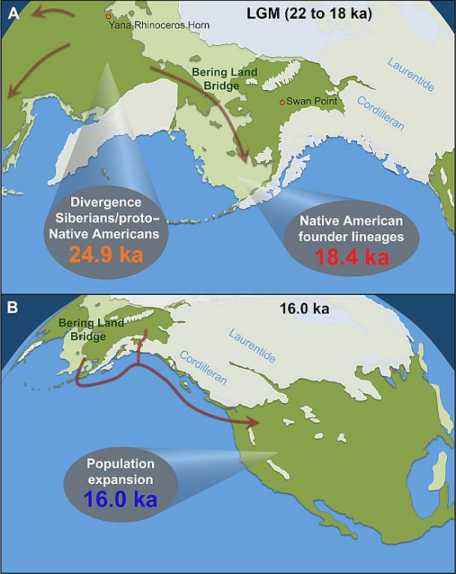There are few accepted basic facts about ancient human migrations around the world. This naked ape
emerged from the African savanna and then spread sporadically from the Middle East, given the logistics of the geographical situation, such as glaciations. The University of Adelaide is home to a unique international group who have produced a clear picture of European colonisations after the Ice Ages and now release an equally valuable account of those pesky dates for Native American progress around the equally forbidding ice sheets over the Bering Straits.
This almost-animal study is different because we deal with a species that works socially, with other species and with effective communication skills that allow cross-cultural exchange, rapid movement over water and different habitats and probably other factors that are yet to be understood fully. There is little difference between for example a marine mammal with some of these abilities or our closest ape relatives. But the human species seems dangerous in its ability to wipe out others and even its own.
A brief summary of the migrations in Europe might help with the apparently single exodus into the Americas. As with North America, the ice sheets prevented human progress and there was also an unexpected genetic turnover, about 4500 years ago. Unlike the American situation, 45% of Europeans still have ancient haplotypes (or genetic lineages.) The first farmers in Europe were involved, emerging from the Near East and Turkey to reach Germany 7500 years ago. These first colonists were replaced 4,500 years ago in some intriguing way, but mid-Neolithic history needs to play a part in discovering this information. Perhaps the kind of detail we have on Oetzi the Ice Man can help to work out what happened 5,300 years ago? More cultures appeared from Iberia and eastern Europe later than this, with the famous Beaker people
entering the continental arena from the south-west.
The Beaker people dominated European cultures after 2800BC and probably formed the pan-European Celtic cultures. The new techniques estimate accurate population sizes as well as the timescale of recent events that we can date. Modern populations can also be well-served by revealing the movements of their ancestors, whose lineages are luckily often intact. That is not the case in America, unfortunately.
10 to 20 thousand years ago, when the Pleistocene ended, the Bering Land Bridge was certainly crossed, because the sea levels were low during the LGM (Last Glacial Maximum.) The Cordilleran and Laurentian ice sheets blocked further access to the south. As temperatures rose, a Pacific route appeared followed by a parallel ice-free corridor to the east off the Rockies. Before the Clovis civilisation appeared, people used these routes in, to reach the tip of Chile (14.6 thousand years ago) within a thousand years or slightly more.
With the Spanish and others destroying native populations, few genetic sources are available, but Bastien Llamas, many varied colleagues from ACAD (University of Adelaide) and too many US and other American universities to mention, alongside the National Geographic Society have just produced Ancient mitochondrial DNA provides high-resolution time scale of the peopling of the Americas in the journal, Science Advances.
A similar paper making use of ancient mitochondrial DNA for European origins appeared inNature Communications.
It is his high-res. product that makes these findings so interesting. 92 whole genomes from pre-Colombian skeletons up to 8.6 thousand years of age gave the raw material. After being isolated in the ice for up to 9 thousand years, the Beringian peoples seem to have moved south at 16 thousand years ago. The structure of the South American populations became very different and remained distinct, although the Spanish caused their extinction in every one of these particular lineages (of which there were 84 haplotypes or genetic groups), whether through disease or culling, we have no way of knowing.
This small group of Founding Fathers (and mothers, as this is maternal DNA) fit best into a single migration that gave us the vast range of modern tribes and peoples. They moved within 2000 years along the inland and Pacific routes. Whether another large migration took place or not, the rapid expansion is unchallenged, with little contact between subsequent peoples, presumable because of geographical isolation by features such as the Andean plateaux and tropical forest.
Previous studies have come to a stop when the molecular clock data fails to gain sufficient evidence on the first entry into the Americas.
Cold dry conditions could have been the trigger to force Beringian peoples to the east, isolating them from their Siberian ancestors. Megafauna kills were reduced in number, with a population of around 2000 females (with accompanying males!) retreating south where the megafauna existed in a shrub tundra habitat. Up to 20 thousand Beringians could have existed in Alaska/the Yukon, but it is impossible to estimate this population accurately. In increasing their population by a factor of 60, the Native Americans must then have finally escaped from this refuge and migrated into more favourable North America climatic conditions by between 16 and 13 thousand years ago. Coastal glaciers also declined rapidly at this time. With this new data, that long isolated stay in Beringia now seems to have been as short as 2.4 thousand years.
Many long branches then led to both modern and extinct ancestral lines. A bottleneck in genetic diversity was created when European colonists ravaged the west coast of South America with mass mortalities where major cultural centres were located. These haplotypes are no longer detected in any population, showing a need for more samples where at least one or two ancient lineages may still exist (probably in the Mesoamerican plateau or high in the Andes.)
Previous studies have indicated that the Native American diversity has been stable for at least 2000 years. This idea must now be modified following this improvement in resolution. Now we can study population change as Central Andean empires expanded with the cost-effective precision of their bone and teeth sampling.










